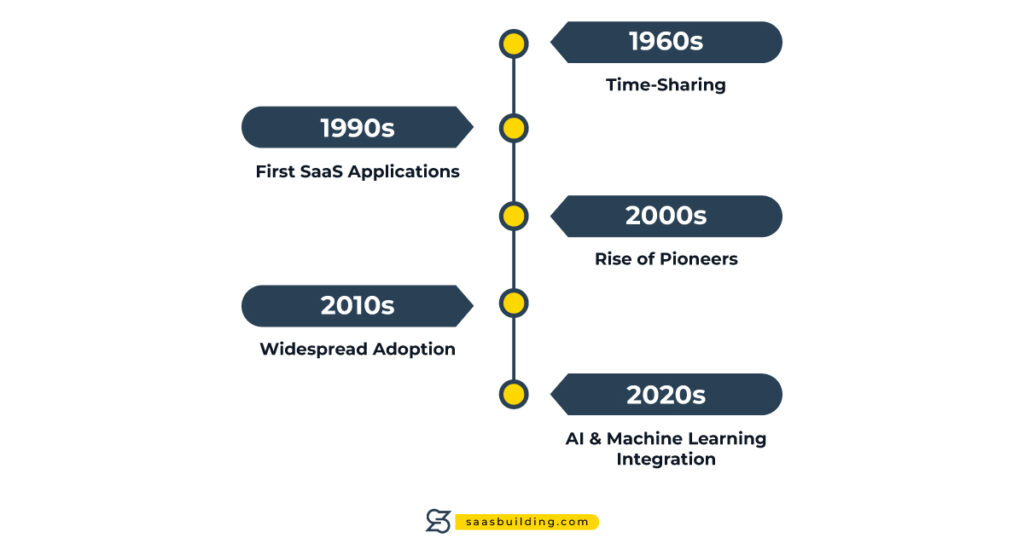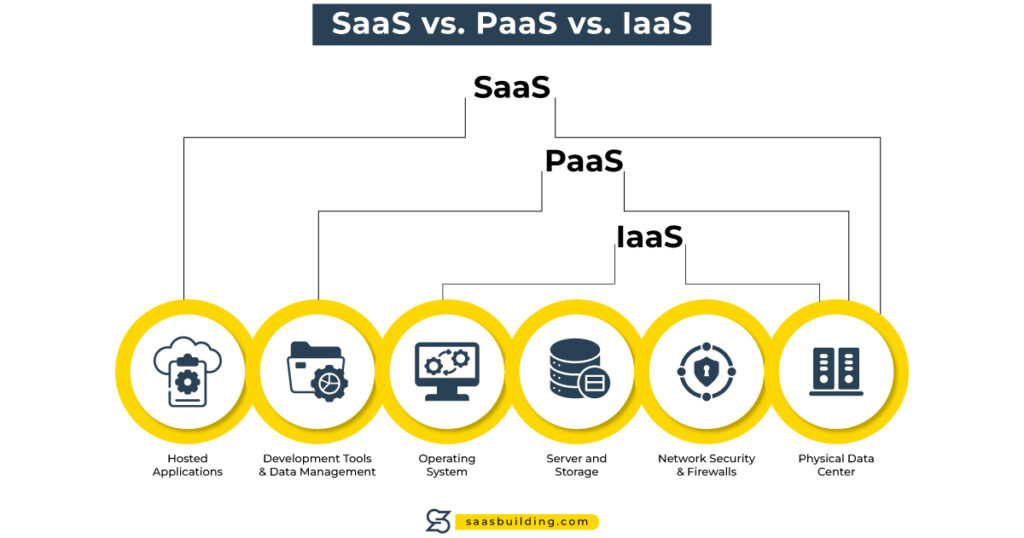Imagine this:
It’s 1961. John McCarthy, a visionary computer scientist, stands before a group of MIT students and boldly declares that
“Computation may someday be organized as a public utility.”
This meant that applications could be used by many people at the same time, kind of like how we share electricity or water.
At the time, it seemed like a far-fetched idea.
Fast forward over fifty years, and here we are, building startups and unicorns (companies valued at over $1 billion) that run on technology we can access online.
Turns out, John McCarthy was onto something. Even though SaaS has been available for a while, many businesses still wonder if it’s the right choice for them.
Are you thinking about transitioning your business applications to SaaS?
Curious about what is SaaS and it’s benefits? Or maybe you’re just trying to figure out if SaaS is yet another confusing business acronym?
If any of this resonates with you, keep reading!
We’ll break down what SaaS is, why businesses are migrating to the cloud, and how it can benefit your organization.
What Exactly is SaaS?
SaaS, or Software as a Service, is a cloud-based software delivery model that allows users to access applications via the internet. Instead of buying and installing software on your local devices, you subscribe to a service and access it through your web browser or mobile device.
In simpler terms, the software you need is delivered and managed remotely, making it easier than ever to stay productive.
Key Historical Milestones in the Development of SaaS
SaaS has come a long way since its early beginnings in the 1960s. Back then, it was known as “time-sharing” and allowed multiple users to access a single computer system simultaneously. Fast forward to the late 1990s, and the first SaaS applications started to emerge, such as Salesforce’s customer relationship management (CRM) software.

Why is the Cloud So Important?
According to Gartner, the SaaS industry is worth approximately $195 billion.
Why? Because businesses that embrace cloud technology can experience growth rates of 19.63% as highlighted by a report from Vanson Bourne.
Today, it’s not a matter of “if” but “when” companies will make the switch.
For instance, the SaaS market is projected to continue growing, with estimates indicating it could reach $1,251.35 billion by 2034, expanding at a CAGR of 13.3% from 2024 to 2034. This growth is detailed in the Precedence Research report here.
Core Components of SaaS
SaaS is built on three core components:
- cloud hosting,
- subscription models,
- user accessibility.
Cloud hosting allows SaaS providers to store and manage the software and data on their servers, making it accessible to users over the internet.
The subscription model means that users pay a recurring fee to access the software, rather than a one-time purchase.
Whereas, the user accessibility ensures that the software can be accessed from any device with an internet connection.

Key Benefits of SaaS for Your Business
Let’s explore some of the key benefits of adopting SaaS:
- No Large Initial Investment: SaaS operates on a pay-as-you-go model, eliminating hefty upfront costs.
- Cost Savings: SaaS can be a significant money-saver! While it may seem pricey initially, when you factor in hardware and IT maintenance costs, SaaS often proves to be the more economical option.
- Seamless Availability: One of the coolest things about SaaS is that it can be accessed from any device with an internet connection. This makes SaaS a great choice for businesses with remote employees or those who are always on the go.
- No IT Headaches: The SaaS provider takes care of all system maintenance, updates, and security, allowing you to focus on running your business.
- Expand and Integrate: Easily integrate with existing software and expand your capabilities without the hassle of traditional installations.
- High Security Levels: SaaS vendors prioritize data security, often providing better protection than on-premise solutions.
- Easy Scalability: Quickly scale up your SaaS users or storage space with just a change in subscription. No lengthy requests or installations required!
- Subscription-Based Model: With SaaS, users pay a recurring fee to access the software, rather than a one-time purchase. This subscription model makes it easier for businesses to budget for their software expenses.
Who Benefits from SaaS Applications?
On average, companies utilize 16 SaaS applications daily to run their operations. If you’ve ever used Dropbox to store photos or an email marketing platform to reach customers, you’ve already experienced SaaS in action.
For medium-sized businesses, SaaS provides a hassle-free and cost-effective solution that offers flexible pricing, easy maintenance, and quick deployment. You don’t need a powerful computer or an in-house server, all you need is a web browser and an internet-connected device, and you’re good to go.
Disadvantages of SaaS
While SaaS offers many advantages, there are also some potential drawbacks to consider.
One of the biggest concerns is data security and privacy. With SaaS, your data is stored on the provider’s servers, which means you have to trust that they will keep it safe. However, as we mentioned before in the advantages that SaaS providers prioritize security, so this shouldn’t be a challenge. Another potential downside is the reliance on internet connectivity, if your internet goes down, you may not be able to access your SaaS applications.
But what can’t be fixed with a good internet connection? 😉
Common Examples of SaaS Applications
There are tons of popular SaaS applications out there, but a few stand out from the crowd. Google Workspace (formerly G Suite) offers a suite of productivity tools, including Gmail, Google Docs, and Google Sheets.
Salesforce, as we mentioned earlier, is a leading CRM platform.
And Dropbox is a popular file-sharing and storage solution.

SaaS vs. Other Cloud Models
SaaS is just one of three main categories of cloud computing, along with Infrastructure as a Service (IaaS) and Platform as a Service (PaaS).
IaaS provides users with access to virtualized computing resources, such as servers and storage. One popular example could be Amazon Web Services (AWS), that provides virtual servers, storage, and networking services to businesses.
PaaS offers a platform for developing and deploying applications. A popular example of a Platform as a Service (PaaS) is Google App Engine. This service allows developers to build and host applications on Google’s infrastructure, providing automatic scaling and integrated services for databases, caching, and more.
SaaS, on the other hand, provides users with access to complete software applications over the internet. Such as Salesforce, it provides customer relationship management (CRM) software delivered over the internet, allowing users to access and manage customer data from anywhere.

Future of SaaS
As technology continues to advance, the future of SaaS looks brighter than ever. We can expect to see more integration between SaaS applications and other technologies, such as artificial intelligence (AI) and machine learning (ML).
SaaS providers will also likely focus on improving data security and privacy, to address the concerns of their users.
What Makes SaaS Successful?
The success of SaaS isn’t just about the technology or the talented people behind it. It’s a mix of several important factors. Sure, having skilled developers and engineers is crucial for building great software, but it doesn’t stop there.
To really succeed, SaaS companies need to understand their customers.
- What do they want?
- What problems do they need solved?
Having a unique value proposition that speaks to these needs is key. It’s all about finding that perfect fit in the market.
Customer success is another big piece of the puzzle. This means providing awesome support, listening to feedback, and making changes based on what customers say. When customers feel valued and heard, they’re more likely to stick around.
On top of that, SaaS companies need a solid plan for how to reach their audience and grow. This includes smart marketing and sales strategies that help them stand out in a crowded market.
By hiring the right professionals across all these areas, you can build lasting relationships and succeed in the fast-paced world of cloud computing.
At SaaSBuilding, we pride ourselves on our ability to attract and nurture top talent in the SaaS industry. Our team of experts is dedicated to creating cutting-edge solutions that help businesses thrive in the digital age.
Conclusion
So, there you have it, a comprehensive overview of Software as a Service. Whether you’re a business owner, an IT professional, or just someone who loves technology, SaaS is definitely worth learning more about. So, what are you waiting for? Start exploring the world of SaaS today.
About the Author
Salman Ahmed
Operations Manager, SaaS Building
Frequently Asked Questions
We help you design, develop, and scale your SaaS product. From the initial idea to a fully functional solution, we’re your partner every step of the way.
Timelines vary based on the complexity, but most projects see significant progress within a few months, with MVPs often ready within weeks.
Absolutely! We offer a free, no-obligation consultation to discuss your needs and how SaaSBuilding can help.
We work with both! Whether you’re just starting out or looking to scale, we tailor our services to meet your specific needs.




